
Every few months, AI shatters another milestone, one that experts said was still “years away.” We see breakthroughs in reasoning, problem-solving, and creativity that would have been unthinkable just 12 months ago. Yet, as AI advances at breakneck speed, one critical question remains unanswered:
How much of a professional’s job can AI already do? And more importantly: Who’s tracking this?
The Real Economic Impact of AI
We have evaluations that benchmark AI’s ability to write code, pass medical exams, and even compose music. But where are the evaluations that tell us, by profession, how much of a doctor’s, lawyer’s, consultant’s, psychologist’s or recruiter’s job AI can actually handle today?
Because at the end of the day, this is what really matters!
It’s not about whether AI can beat a video game or generate poetry, it’s about:
- When do we hit 50%, 70%, or 90% automation in the professions that power our economy?
- How many of the daily tasks in consulting, law, finance, and medicine are already being automated?
- When does an AI-powered agent replace 80% of a recruiter’s workflow?
Right now, nobody is tracking this at scale. There’s no standardized way to say:
- “A corporate attorney’s daily workload is now 60% automatable.”
- “A financial analyst’s research tasks are 80% automatable.”
- “A customer service rep’s role is 95% handled by AI.”
And worse, nobody is systematically preparing for it.
The Pattern No One Wants to Acknowledge
The cycle KEEPS repeating:
1. Someone claims an AI capability is still far off.
2. Within months, a team proves it’s possible.
3. People shrug and move on, without addressing the consequences.
I’ve seen this in legal research, medical diagnostics, financial analysis, and even consulting. AI isn’t replacing entire professions overnight, but it is rapidly automating the tasks that make up those professions.
So the real question isn’t if AI will transform jobs. It’s:
- How much of a given profession can AI already do today?
- What will that number be in 12-18 months?
- And what are we doing about it?
The Myth of “New AI Jobs”
A common response is: “AI will create millions of new jobs.” But where are they?
📌 Who is defining them?
📌 How many exist right now? A real number, not a farfetched guess
📌 How many people are being trained for them?
Companies are gambling with headcount faster than they are reskilling employees. The reality is, AI is replacing tasks just as fast as it’s creating new opportunities, and most workers aren’t being prepared for the shift.
The Exception: A Handful Are Seeing the Vision
At The Gen AI Company, we’ve started to work with a handful of forward-thinking clients who see, as we do, this shift coming. They recognize that AI isn’t just about cost-cutting or workforce downsizing. It’s about rethinking how humans and AI can innovate together.
But here’s the reality: this isn’t happening at scale.
Industries need to step up in 2025 to proactively reshape workforces, not just wait for AI and automation to displace people and figure it out later.
The conversation can’t just be about AI replacing tasks.
It’s about ensuring AI-driven innovation creates value for businesses and workers alike.
What Needs to Happen: Practical Next Steps
We know that AI is disrupting entire professions, so how do we get ahead of it?
Systematic AI Job Evaluations:
✔ Conduct ongoing evaluations by profession, tracking how much of a job’s tasks AI can already handle.
✔ Create automation thresholds, e.g., at 30%, 50%, or 80% automation, what needs to happen?
Proactive Workforce Reskilling:
✔ Start upskilling workers BEFORE their roles are fully disrupted.
✔ Build job transition pathways, if AI absorbs 70% of a job’s workload, what’s the next viable career move?
AI Job Creation Roadmap:
✔ Define what new AI-powered careers actually look like, and build accessible training programs for them.
✔ Stop assuming that displaced workers will magically transition to “AI jobs” without guidance.
Business & Policy Changes:
✔ Ensure that businesses don’t just use AI to cut costs but reinvest in human capital.
✔ Government and corporate leaders must align AI-driven automation with workforce strategy.
Who’s Going to Step Up?
We are doing it, but we can’t do it alone. It could be led by private industry, government, or academia, but others need to start doing it as well.
Because right now, we’re heading straight toward a tipping point, and we are completely unprepared.
Let’s STOP reacting after the fact. Let’s start tracking, preparing, and acting now.
What do you see happening in your industry?
How much of your daily work is already being automated?


0 Comments